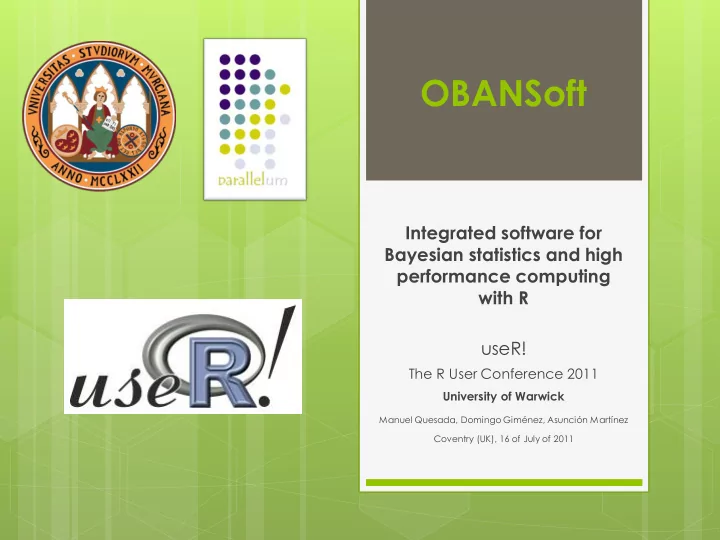

OBANSoft Integrated software for Bayesian statistics and high performance computing with R useR! The R User Conference 2011 University of Warwick Manuel Quesada, Domingo Giménez, Asunción Martínez Coventry (UK), 16 of July of 2011
Content 1. Introduction and motivation 2. Preliminary analysis of the problem 3. Application design 4. Performance and parallelization 5. Conclusions and future directions
Introduction What is the motivation of the project? To fill the gap with respect to applications to Bayesian analysis of data with minimal prior information… …eventually high performance computing applied to problems of Bayesian statistics. As a starting point we have developed the first version of the desktop application OBANSoft with: A modular design to facilitate: Future extension with new functionality. Non dependence on the statistical model. Try to include aspects of technology integration, parallelism and transparency to the user (self-optimization) . The integration of different languages, tools and parallel libraries (OpenMP, MPI, CUDA … ) would be done transparently to the end user, who only uses the graphics application that remains invariable.
Introduction UMU: Parallel Computing Group. Research Groups Experience in the development and optimization of parallel code. Including self-optimization techniques and the application of parallel computing in various scientific fields. UMH: Bayesian Statistic Group. Experience in the development of simulation codes applicable to the resolution of Bayesian analysis in various fields.
Preliminary analysis Summary of the methodology. Addressing various areas leads us to divide the methodology in 4 parts: Part 1 : development of a Bayesian operations catalog to be supported by the application. Part 2 : decision of the technology and resources to be used. Part 3 : design and implementation of the library and desktop application. Part 4 : preliminary parallelization of the simulation algorithms, and study of the performance.
Preliminary analysis Summary of the methodology. Addressing various areas leads us to divide the methodology in 4 parts: Part 1 : development of a Bayesian operations catalog to be supported by the application. Part 2 : decision of the technology and resources to be used. Part 3 : design and implementation of the library and desktop application. Part 4 : preliminary parallelization of the simulation algorithms, and study of the performance.
Preliminary analysis Artifacts, tools and technology After a preliminary analysis of the alternatives available to perform Bayesian analysis … Software Element Technologies Libraries Statistical Library Java (JSE) + R JRI Desktop Application Java Swing Swing Parallelization Parallel R Snow Fall … the above options were selected (free and reusable software platforms).
Application Design The model Model-View-Controller
Application Design Object Model
Application Design View objects
Application Design Controller Objects The Main Controller manages all events that require the participation of the “ MainForm ”: Main Controller Modular organization Other Objects …
Application Design Bayesian algorithms. Integration of technologies.
Application Design Bayesian algorithms. Integration of technologies.
Application Design Bayesian algorithms. Integration of technologies.
Application Design The R-Model and its integration with R.
Performance and parallelization What algorithms to optimize and parallelize Among all programming algorithms, we focus on simulation algorithms. They require more runtime. Critical point in the resolution of a Bayesian analysis. All analyses are based on the simulation. They are used for Bayesian inference models. However… there are 27 , Who starts…?
Performance and parallelization Experiment 1: Trend growth Trend of the simulators Time (Msecs) Uniform Exponential Normal Cauchy Snedecor F Number of simulations
Performance and parallelization Experiment 2: Comparison of simulators Average running time for 1 million of simulations Simulation algorithms There were two types of simulators: simple simulators and compound simulators .
Performance and parallelization Composite Structure Simulator One invocation of a simple function of size X. X invocations of another simple function ( function chain ) with parameters extracted from the above function. Code 1: simulation algorithms of the composite function Gamma-Gamma The experiments indicated that the function chain consumes 90% of the total execution time. Chain function in parallel with R parallel code (library).
Performance and parallelization Parallelization for shared memory ( SnowFall ) Code 2: Parallel algorithm chain simulator function (Gamma-Gamma)
Performance and parallelization Experiment 3: Results of the parallelization Parallelization of the function chain Time (sec) Sequential 2 3 4 Number of processors The reduction in the execution time is far from the theoretical limit… (Efficiency only 50%) What is the reason…?
Conclusions Current work…. We are studying a Bayesian Analysis algorithm: study of parallelism (Snowfall, multithreaded BLAS, OPENMP … ) We analyze the simulation codes programmed in C to compare with the corresponding R versions. IMSL Libraries for linux. Parallelize these algorithms programmed in C and compare SnowFall against OpenMP .
Conclusions Future work…. With the tool we cover that gap in the applications of Bayesian statistics, and it serves as a basis for integrating future developments hiding parallelism. Integrate other models that involve the simulation algorithms based on Markov chains . Expand OBANSoft modules with new functionality. Adapt the statistical model in a website to exploit as Cloud Computing .
Conclusions References Katagiri, T., K. Kise, H. Honda, and T. Yuba (2004). Effect of auto- tuning with user’s knowledge for numerical software. In Proceedings of the 1st conference on Computing frontiers, pp. 12 – 25. ACM. Quesada, M. (2010, Julio). Obansoft: aplicación para el análisis bayesiano objetivo y subjetivo. estudio de su optimización y paralelización. Master’s thesis, Universidad de Murcia. SnowFall (2011). Url http://cran.r- project.org/web/packages/snowfall/. Yang, R. and J. O. Berger (1996). A catalog on noninformative priors. Discussion Paper, 97-42, ISDS, Duke University, Durham, NC.
Thank you for your attention. Any questions…?
Recommend
More recommend